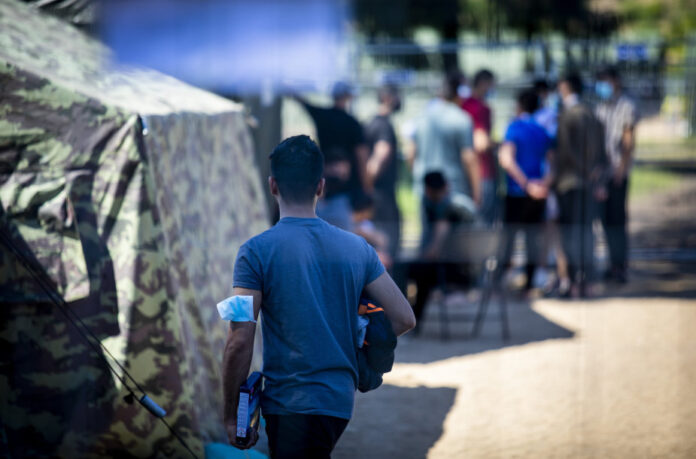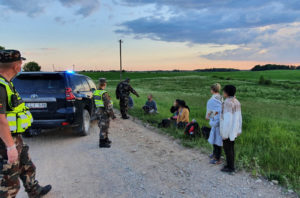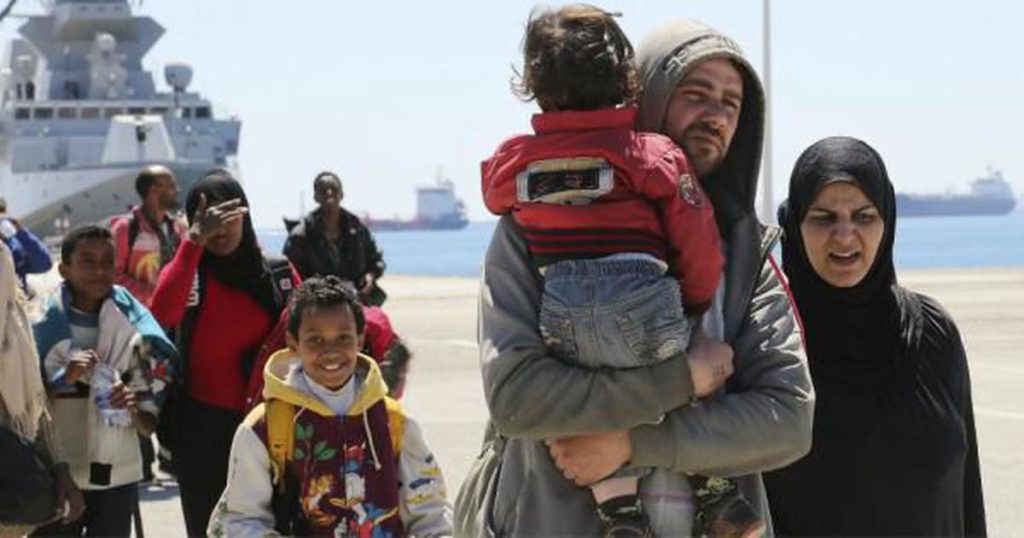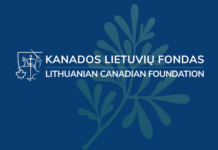
Lithuania is joining the ranks of countries receiving streams of refugees as a result of unrest throughout the world. Leaders are concerned about managing the influx and its effects. In an article on the popular Lithuanian news website 15min.lt journalist Beatričė Bankauskaitė presented several scenarios discussed by Interior Minister Agnė Bilotaitė as refugees enter Lithuania via Belarus.
The minister emphasized that at this time it is important to establish the fact that Lithuania is not a convenient stopping point en route to Europe for refugees whose ultimate goal is not Lithuania. On June 21, the increase in illegal immigration and the Belarusian situation was discussed at a meeting of the State Security Council. The minister noted that there are currently 440 known illegal immmigrants in Lithuania, six times more than at this time last year. (Lithuania’s population as of January 2021 is 3,029,118.) Border security is a priority, she said, with 11.5 million euros earmarked for this, completing the border protection project should take a year.
The minister noted that there is still some room for illegal migrants in the encampments that are already set up, and they are even suitable for colder weather. Plans are also in place for the eventuality that 500, 1000 or even 10,000 refugees should arrive. The lowest number would fill up all the space at the Pabradė Foreign Registration Centre, as well as the border school, and would require additional municipal facilities and food services. All of this as well as a tent city for 1000 would be necessary if that many people arrived in Lithuania. Two more camps as well as the rental of modular homes would be necessary if 10,000 refugees came to Lithuania.
According to Defense Minister Arvydas Anušauskas, the influx of thousands of refugees is not realistic, however, preparations must be made to ensure the security Lithuanian and European Union borders. He spoke about a physical border wall, which would cost approximately 15 million euros. A discussion about a wall at the border with Belarus is currently underway, although no decisions have yet been made.

National Defense Committee chair Laurynas Kasčiūnas noted that illegal immigration must be stopped within the countries the refugees are coming from , for example, Iraq and Turkey. He agreed with building a wall, taking an example from Norway, which has a physical wall at its border with Russia, and Spain, where a wall is currently being built. It would not be meant to isolate Lithuania from the free world, he said, but rather to thwart the efforts of an authoritarian regime to infringe on the country’s rights and freedoms and political independence. It would also be a more effective barrier against contraband, which Minister Bilotaitė agreed is a huge problem, especially because it is a source of revenue for the Belarusian regime. Border Security Services must also be fully pro-active in this regard.
Over the past two weeks the Ignalina region has recently become the hotspot for detaining migrants from Belarus, in 12 groups totalling about 150 people originally from Iraq, all requesting asylum.
The Lithuanian parliament is to vote on the amended 2021 budget which would provide 172,000 euros to finance the increasing burden on courts that will have to determine the legal status of new immigrants.
Experts are also urging the government to prepare for even more immigrants from Belarus as repression of the opposition continues there. The situation may become critical not only because of Belarusian refugees escaping the authoritarian regime, but because, as a form of political blackmail, Minsk may open its borders to the West for migrants from Iran, Iraq and Syria.
With news from BNS, LRT.lt
Global Migration Trends
Growing displacement despite pandemic
Immigration to Lithuanian has increased over the past year (see article Increasing Immigraion to Lithuania), which may be unusual for a small Norther European country, but to be expected considering world trends. And what are those trends? For answers, we look to the UNHCR,the UN Refugee Agency, a global organization dedicated to saving lives, protecting rights and building a better future fro refugees, forcibly displaced communities and stateless people.
While the full impact of the COVID-19 pandemic on wider cross-border migration and displacement globally is not yet clear, UNHCR data shows that arrivals of new refugees and asylum-seekers were sharply down in most regions – about 1.5 million fewer people than would have been expected in non-COVID circumstances, and reflecting how many of those seeking international protection in 2020 became stranded.

Despite COVID-related movement restrictions and pleas from the international community for a ceasefire that would facilitate the COVID-19 response, displacement continued to occur – and to grow. As a result, above one per cent of the world’s population – or 1 in 95 people – is now forcibly displaced. This compares with 1 in 159 in 2010.
During 2020, several crises – some new, some longstanding and some resurfacing after years – forced 11.2 million people to flee, compared to 11.0 million in 2019. This figure includes people displaced for the first time as well as people displaced both within and beyond countries’ borders.
When considering only international displacement situations under UNHCR’s mandate, Syria topped the list with 6.8 million people, followed by Venezuela with 4.9 million. Afghanistan and South Sudan came next, with 2.8 and 2.2 million respectively. Turkey continued to host the largest number of refugees with just under 4 million, most of whom were Syrian refugees (92%). Colombia followed, hosting over 1.7 million displaced Venezuelans. Germany hosted the third largest population – almost 1.5 million, with Syrian refugees and asylum-seekers as the largest group (44%). Pakistan and Uganda completed the top-5 hosting countries, with about 1.4 million each.
New UNHCR estimates show that among refugees and Venezuelans displaced abroad, almost one million children were born in displacement between 2018 and 2020, an average of between 290,000 and 340,000 per year. Many of them are at risk of remaining in exile for years to come, some potentially for the rest of their lives.
With many governments closing borders for extended periods of time and restricting internal mobility, only a limited number of refugees and internally displaced people were able to avail themselves of solutions such as voluntary return or resettlement to a third country.
Some 251,000 refugees were able to return to their country of origin in 2020, either assisted by UNHCR or spontaneously. This is the third lowest number of the past decade, and it continues a downward trend from the previous two years. Impediments to returns in many countries of origin include ongoing insecurity, the absence of essential services and the lack of livelihood opportunities.
Refugees were not the only forcibly displaced people struggling to access solutions. In comparison with 2019, 40 % fewer IDPs, internally displaced people, (3.2 million versus 5.3 million in 2019) were able to return to their place of residence, leaving millions of IDPs in protracted displacement. Almost half of all IDP returns were concentrated in the Democratic Republic of the Congo (1.4 million).
In the early phase of the pandemic, UNHCR and the International Organization for Migration put on hold resettlement departures for several months amid border and travel restrictions around the world. While these activities subsequently resumed, only 34,400 refugees were resettled to third countries in 2020, two-thirds of them assisted by UNHCR. This compares to 107,800 the year before and marks a dramatic 69 % decline – at a time when 1.4 million refugees are estimated to be in need of resettlement.
With numbers having risen to more than 82 million, the question is no longer if forced displacement will exceed 100 million people – but rather when. UNHCR realizes the need for preventing conflicts and ensuring that displaced people have access to solutions has never been more pressing. The early months of 2021 offered some hope, even as conflict and displacement continue in many parts of the world. The announcement by the US Government to admit more resettled refugees – up to 62,500 in 2021 and up to 125,000 in 2022 – will provide solutions to more of the world’s most vulnerable refugees, especially if other countries follow suit. Another positive step is the Government of Colombia’s announcement in February 2021 to grant temporary protection status to more than one million Venezuelans.
Where does Canada stand?
The Asian countries of India, China and the Philippines are sure to once again be the top three most important sources of new permanent residents to Canada in 2021 as Covid-19 vaccines are rolled out and travel restrictions fall away.
Before the pandemic hit and slowed immigration to Canada to a trickle in 2020, those three countries and Nigeria, Pakistan and the United States accounted for more than half of the 341,175 new permanent residents to Canada in 2019. Since then, Ottawa has announced ambitious new immigration targets for the coming three years. In late October of 2020, Canada announced it would be welcoming 401,000 new permanent residents in 2021, 411,000 in 2022 and 421,000 in 2023. Prior to the pandemic, the previous plan set targets of 351,000 in 2021 and 361,000 in 2022.
A return to normal immigration patterns with these higher targets would mean that in 2021 Canada could expect: 100,568 new permanent residents from India; another 35,538 immigrants from China; 32,688 from the Philippines; 14,805 from Nigeria; 12,684 from Pakistan; 12,667 from the United States; 11,891 from Syria; 8,260 from Eritrea; 7,173 from South Korea, and 7,115 from Iran in the same year.
In the five years ending in 2019, immigration from India, the greatest source of new permanent residents to Canada, skyrocketed, growing by almost 117.6 % from 39,340 in 2015 to 85,590.
In that last year, more than 77.8 % of immigrants to Canada from India made the move under economic programs. A majority, 55.6 %, or 47,600 of them, made the move under worker programs, including the Atlantic Immigration Pilot, Canadian Experience, Caregiver, Skilled Trade and Skilled Worker programs.
News from https://www.unhcr.org/flagship-reports/globaltrends/Immigration.ca



























